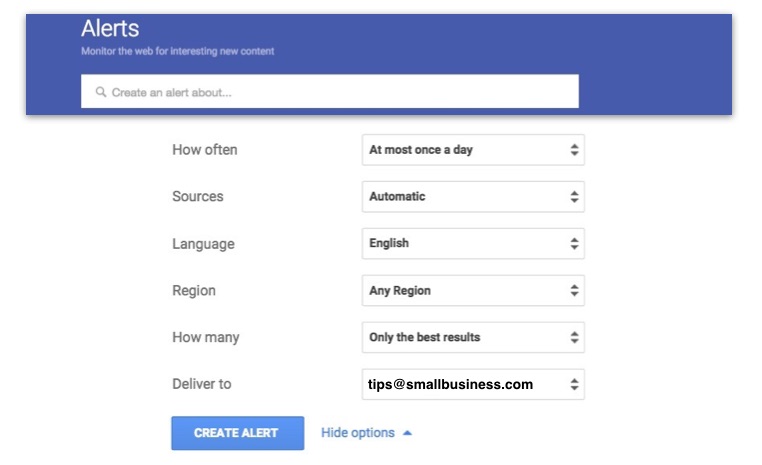The success of your business hinges on how well you serve your customers, not on how obsessed you are with your competition. However, chances are that you spend a little time keeping up with what your competitors are doing. Lucky for you, Google and other web services offer tools that can be used to watch what your competition is doing—without any unethical behavior on your part. They don’t even require fake email or Twitter accounts. The best feature? They take so little time, you can focus on what’s really important—your own company and its customers.
1. Use Google Alerts (email).
One of the most common ways to keep up with any topic (including a competitor), Google Alerts monitors the web for the new appearance of a word or phrase you request. It’s easy, too.

- Visit Google Alerts.
- In the “Create an alert about” box, enter the words you want to get email notifications for.
- Click Show options to say how often you get alerts, what types of results you want to get, and more.
- Click Create Alert.
- Once your alert is set up, you’ll start getting emails any time there are new search results for your keywords.
- You can also create an alert by clicking the + next to any of the suggested topics on the Google Alerts page.Tip: Use “operators” in setting up your search to get the precise information you are seeking. If you don’t know what an operator is, read this from Google.
2. Use a newsreader like Feedly.
Facebook made the term “news feed” popular—the constantly changing list of updates on your Facebook home page. Because you are “friends” with the people on your Facebook account, you see their updates. An RSS newsreader, like Feedly, is similar. It works the same way as a Facebook news feed, except it follows new information added to any website, blog or press release. (And you don’t have to be “friends” or “like” someone to follow them.)
(Note: For some reason, people–even smart ones–think the term RSS newsreader is something obscure, so they use terms like “personal magazine” tor describe it. That’s okay.)
Spend 10 minutes watching this video tutorial and another 20 minutes setting up a Feedly account. Doing so will save you hours each month. How? By doing away with the constant web surfing you do to visit all the sites you follow. While the Boise State instructor in this tutorial uses a browser-based version of Feedly, one of the best features Feedly provides is native apps and applications that allow you to access the news it tracks using any smart device.
3. Use Google Alerts via a newsreader.
Did we mention that Google Alerts can be a pain in your email inbox? A good solution is to use the option on Google Alerts that allows you to subscribe to alerts via RSS rather than email. Look for the option under the “Deliver to” tab.

4. Use Twitter’s “private lists.”
When using Twitter, there may be times when you don’t want a user to know you are “following” (subscribing to) their tweets. In such cases, there are ways to follow topics, companies or individuals on Twitter without those Twitter accounts seeing you listed among their followers. Sure, you could set up a fake account, but chances are, you’d forget to check it.
A better way is to create a Twitter list.
Why?
- You don’t have to “follow” a Twitter account to add it to a list.
- You don’t have to make Twitter lists public.
Put those two features together and you can follow anyone on Twitter who makes their feed public. (Click here for instructions on setting up and using Twitter lists.)
